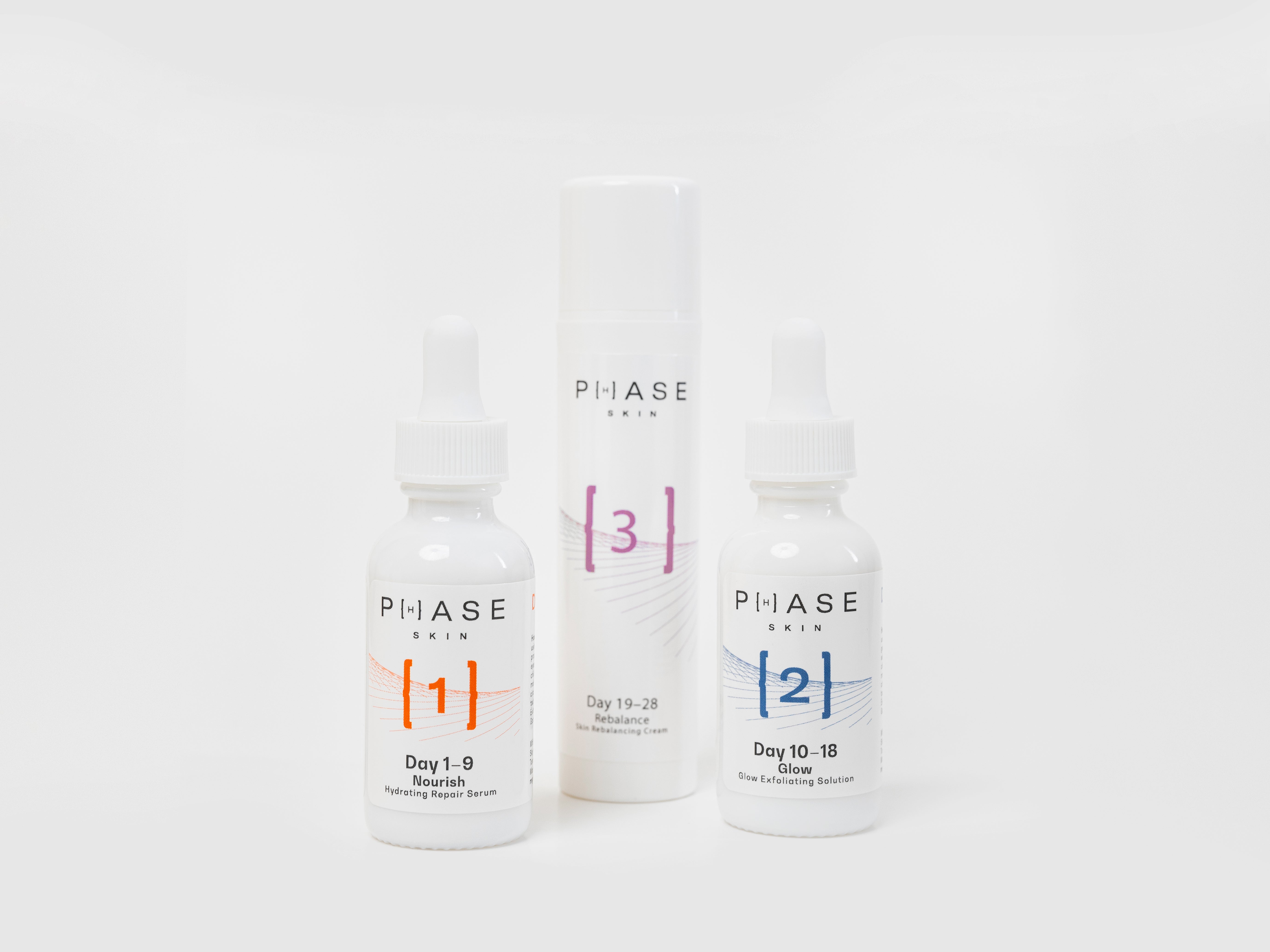They say that working from home can feel lonely, but lately, a rowdy guest has been joining me for every Zoom meeting: a big cystic pimple. Oversized, throbbing, and glowing red, it hogs the spotlight on my chin and on my video calls (if only I could put it on mute).
Frustratingly, this isn’t the first time I’ve shared my screen with a breakout. In fact, like me, over 60% of women experience hormonal acne around that time of the month. These pimples feel as inevitable as PMS-fuelled cryfests watching Normal People; that all we can do is dab on some spot cream, try not to pop them, and wait until they come back in four weeks before our next period.
AdvertisementADVERTISEMENT
But what if syncing our skincare to our menstrual cycle could help curb these flare-ups and other skin concerns? That’s the premise behind P{H}ASE Skin, the first Canadian hormone-based skincare line that calls for switching up your products depending on whether you’re on your period, ovulating, or in between. It’s one of a growing number of beauty brands — including US.-based skincare companies Amareta and Knours. — promising women that we can biohack our way to better skin.
“What your skin needs today isn’t what it needs all month long,” says Toronto-based medical laboratory scientist Kristin Kurian, co-creator of P{H}ASE Skin. For example, “when you’re menstruating, your skin is dry and dehydrated,” she explains, pointing to the drop in oestrogen that happens during your period, hormonal shifts she and her co-founder, beauty biz veteran Stephanie Sharabur, spent months mapping.
To help balance out that dip, P{H}ASE Skin’s kit of three treatments includes a hydrating serum packed with moisture-grabbing hyaluronic acid and mineral-rich algae. Later, when oestrogen ramps up before ovulation, skin can handle more intense treatments, according to the P{H}ASE Skin team, so that’s when you’d switch over to its exfoliating solution. Finally, during the luteal phase (that bloated time between ovulation and your period — oh, the joy), when a rise in acne-causing androgens sets the scene for those Zoom-disrupting pimples, its rebalancing cream contains turmeric oil and larch-tree extract to help with breakouts. “The goal is to glow all month long,” says Kurian.
AdvertisementADVERTISEMENT
The notion of changing your habits based on your cycle was pioneered (and trademarked) by New York–based integrative nutritionist Alisa Vitti. She founded the cycle-based wellness program FLO Living in 2001 and has a growing community of over half a million cycle-syncers. (Gabrielle Union and Freida Pinto are said to be fans.) Vitti’s approach calls for switching up your food, exercise, and even the way you work based on the four phases of the menstrual cycle. “Instead of trying to have the same schedule every day [which aligns more with the male 24-hour hormonal cycle], you have four schedules every month,” says Vitti, who published her second book, In the FLO, this past January.
She says tweaks like steering clear of cardio during the second half of your cycle when energy levels taper down, rotating your go-to veggies week by week to get different micronutrients as your hormones fluctuate, and scheduling your busiest days during your productive luteal phase (who knew?) can make you healthier and less stressed. Vitti applies the same cycle-syncing strategy to her skincare too, although it’s more of a self-guided approach, rotating products and treatments in tandem with her hormones.
But do these hormonal-based systems actually work? Switching up your skincare products on a near-weekly basis seems like an overzealous — and potentially pricey — approach. “Anything like that is such an oversimplification,” says Toronto dermatologist and certified menopause practitioner Dr Jennifer Pearlman. “Hormones are really just one small piece of determining your skin’s needs.” Your Fitzpatrick skin type, ethnicity, age, lifestyle, and sun exposure all play a role, she says.
AdvertisementADVERTISEMENT
Dr Pearlman adds that oestrogen fluctuation during a monthly cycle doesn’t last long enough to spur any noticeable changes. (She does, however, often see hormonal acne flareups in her patients.) “Our skin, eyes, joints, and vaginas all dry out when oestrogen decreases, but the dryness is about chronically low oestrogen." That’s partly why menopause can leave you with fine lines and dry skin. To help with this, P{H}ASE Skin offers its Menopause Serum with collagen-boosting vitamin C — an ingredient that gets Dr Pearlman’s backing, though she recommends medical-grade formulas through doctors' offices.
Ultimately, to help with my hormonal acne, I’ve landed on a mixed approach, leaning on P{H}ASE’s treatments in the mornings, turning to some of my derm-approved old faithfuls come bedtime, and taking hormone-balancing supplements recommended by my naturopath in between. So far, it seems to be working, but it all needs more research, says Dr Pearlman — and both Kurian and Vitti agree.
“Women have been proactively excluded in medical fitness and nutrient studies because they’re ‘too complicated,’” says Vitti. “It’s institutionalised gender bias that has not been called out, but it’s imperative for our health to have more research done on this biological rhythm and its massive implication for the key systems of our body.”
A drive for more awareness and openness fuels the P{H}ASE Skin team, too. “We’re all women; we all have these hormones. Why aren’t we talking about them?” asks Kurian. “We want to get the conversation going. Because it truly affects so many areas of our lives — our skin, but also our mood, our body, how we see ourselves.
Refinery29's selection is purely editorial and independently chosen – we only feature items we love! As part of our business model we do work with affiliates; if you directly purchase something from a link on this article, we may earn a small amount of commission. Transparency is important to us at Refinery29, if you have any questions please reach out to us.
